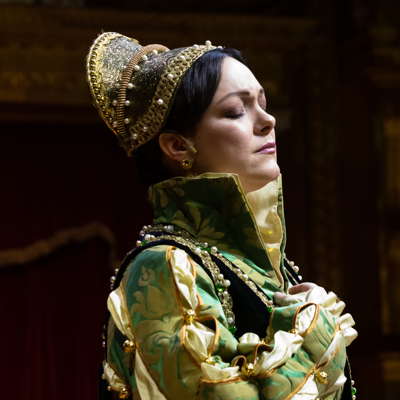 FROM ROME: From December 2009 until March 2023, the late Giuseppe Pennisi sent us regular reports from the Italian opera and classical music scene.
FROM ROME: From December 2009 until March 2023, the late Giuseppe Pennisi sent us regular reports from the Italian opera and classical music scene.
- Giovanni Stefano Carbonelli
- Robert LaPorta
- Bob Chilcott
- Roger Quilter
- Gernot Wolfgang
- Czech Republic
- Jan Ladislav Dussek
- Debussy: Trois Chansons de Charles d'Orléans
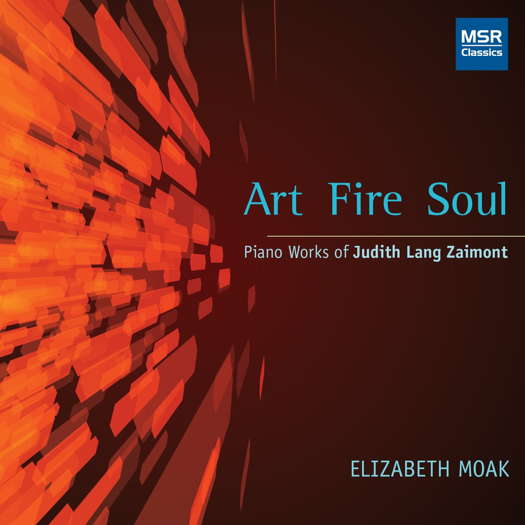 SPONSORED: CD Spotlight. An Encyclopedic Recital - Elizabeth Moak plays Judith Lang Zaimont, heard by the late Howard Smith.
SPONSORED: CD Spotlight. An Encyclopedic Recital - Elizabeth Moak plays Judith Lang Zaimont, heard by the late Howard Smith.
All sponsored features >>
In the Easter Egg
GIUSEPPE PENNISI takes a critical look at two April 2021 performances of Verdi's 'La Traviata'
On the evening of 3 April 2021, Easter Eve, several thousand Italians found a pleasant HD surprise in their Easter Egg: in prime time, on TV channel Sky Classica HD (channel 136), a brand new La Traviata especially conceived for television and produced by Catania's Teatro Massimo Bellini and Sky Classica HD. It had been announced through a press conference in Catania only a few days earlier. Another TV La Traviata was in the offing: it had been prepared for several months by Rome Teatro dell'Opera and was shown on channel Rai5 on 9 April.
The Catania La Traviata will be replicated several times on Classica HD and probably on the foreign channel 'brothers' of Classica HD such as the French German Channel Arte. A DVD with a large international house is also under discussion. The American market and those in the Pacific Basin are waiting to see and hear the production.
It is a unique and innovative production, conceived collectively by the two stage directors Paolo Gavazzeni and Piero Maranghi, the cinema director Francesco Fei, the Massimo Bellini superintendent Giovanni Cultrera di Montesano and the Artistic Director Fabrizio Maria Carminati. It focuses on the extraordinary beauty of the theatre, from the stage to the audience seat area, from the boxes to the foyer. It is designed to be shot entirely inside the theatre. For the first time, the Massimo Bellini opera house becomes the background and scenography of the staging of an opera.
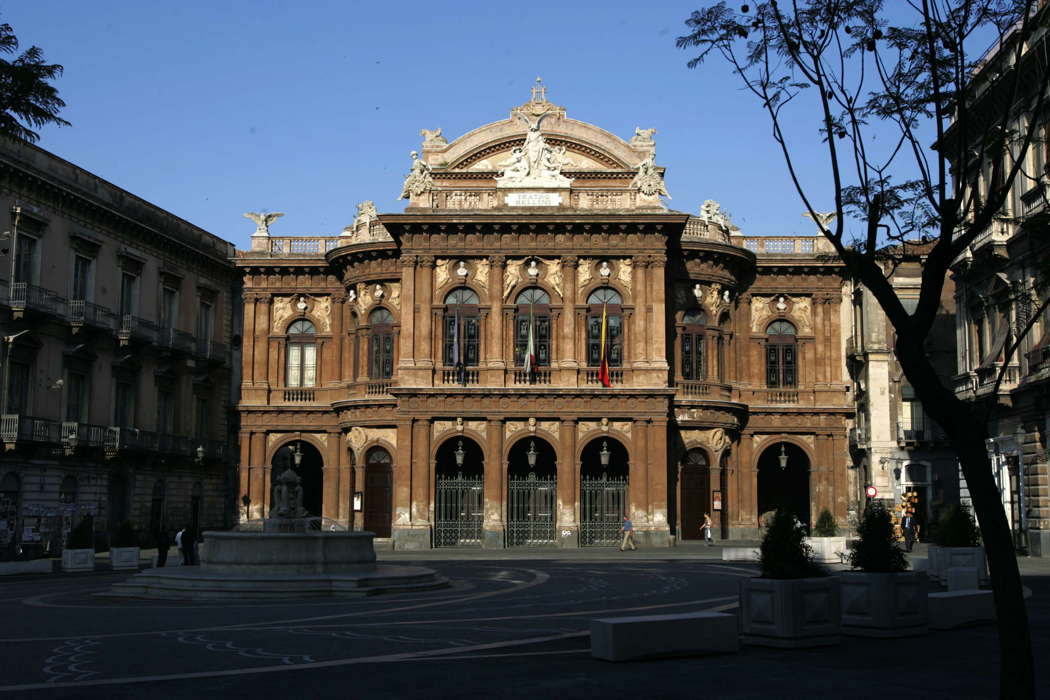
Teatro Massimo Bellini in Catania, Sicily, in 2007
A few words about the theatre. Built at the end of the nineteenth century - it was inaugurated in 1890 with Norma by Vincenzo Bellini - it is considered by many to be the most beautiful and the most elegant of the Italian opera houses. With a capacity of about nine hundred seats, it is ideal for voices. It has acoustics considered perfect so much that Joan Sutherland and Richard Bonynge listed it as their favourite recording venue in Italy. It has had glorious periods. During the twentieth century, the best international conductors and singers performed there. It has been home to debuts that have interested the international music press. In the last quarter of a century, as the economic and financial woes of the Catania area increased, the theatre declined. It has never been included among the twelve Italian opera foundations financed by the Central Government. Yet, it is the only teatro di tradizione in Italy with a permanent chorus and orchestra. In the last few years, it developed joint ventures with European opera houses with low production costs, including Moscow's Helikon Theatre, one of the most innovative worldwide. After a difficult phase, entrusted to a new management and with three-year financing plans by the Regional and City Governments, it is in full recovery, compatible with the constraints of the pandemic. A concert directed by Riccardo Muti is programmed; Rigoletto, conducted by Plácido Domingo and directed by Leo Nucci, is planned this summer at the Roman Theatre of Taormina, as well as in autumn a great opening of the season with Marina Rebeka in Norma.
In the main roles of La Traviata were the Russian soprano Irina Lungu (Violetta), the Romanian tenor Ştefan Pop (Alfredo) and the Italian baritone Franco Vassallo (Giorgio Germont). With them, on stage, were Anastasia Boldyreva (Flora Bervoix), Albane Carrere (Annina), Blagoj Nacoski (Gastone), Michele Patti (Baron Douphol), Claudio Levantino (Marquis D'Obigny), Gabriele Sagona (Dr De Grenville), Riccardo Palazzo (Giuseppe) and Gianluca Failla (Domestico/Commissionario). The orchestra of the Teatro Massimo Bellini was conducted by Fabrizio Maria Carminati, the chorus has been prepared by Luigi Petrozziello; the choreography was signed by Lino Privitera; the costumes by Giovanna Giorgianni, the lighting by Antonio Alario.
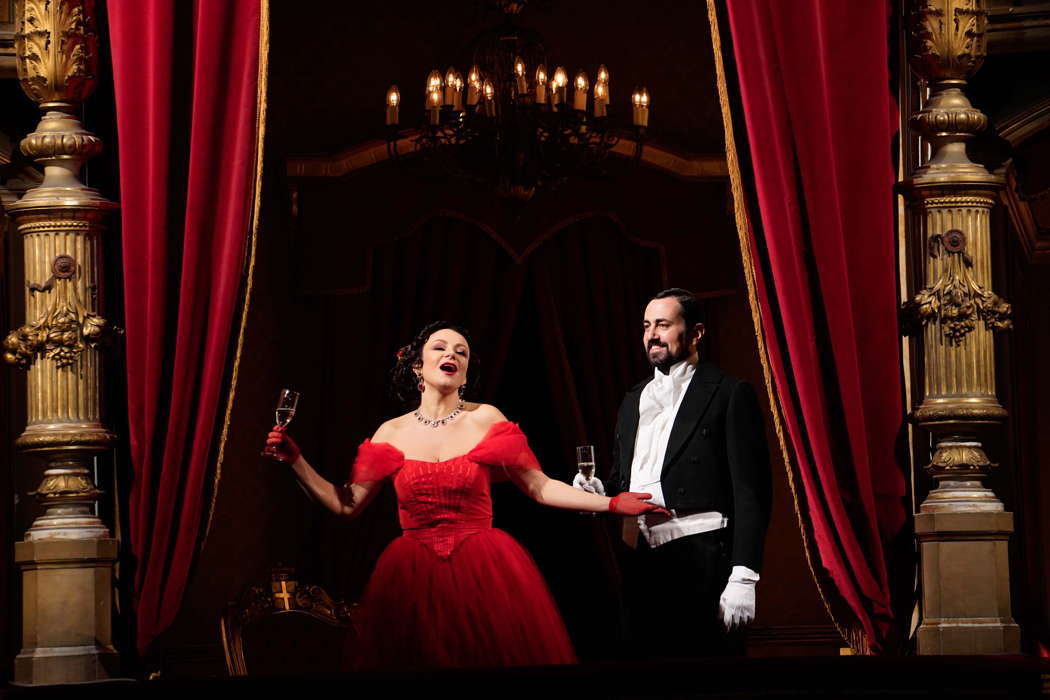
Irina Lungu as Violetta and Gabriele Sagona as Dottore Grenvil in Act I of La Traviata at Teatro Massimo Bellini. Photo © 2021 Giacomo Orlando
Overall, the production is quite traditional, which is alright for TV showing to a large international audience. The chorus members are always in the four tiers of boxes. The first act has, as a central element, the Royal box, for the Violetta and Afredo duets and for Violetta's main arias. The first scene of the second act is the grand foyer with a view on the terrace and a lookout on the wide open space; the second scene evolves in the orchestra seats space with the ballet and the green gambling table.
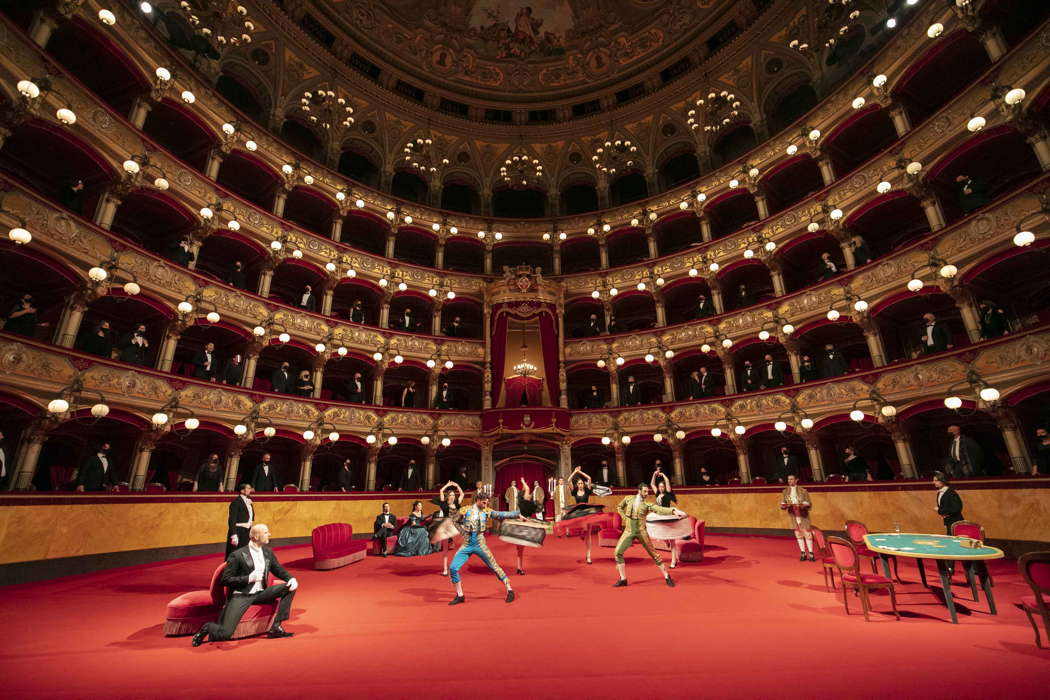
Act II Scene 2 of La Traviata at Teatro Massimo Bellini. Photo © 2021 Giacomo Orlando
The third act is on the bare stage with a couch and two armchairs. It is, all and all, effective, even though a few plants in the foyer would have given a better idea of the country garden, where, according to the libretto, the first scene of the second act takes place.
A note on Irina Lungu's costumes: they made me remember a visit I made more than fifty years ago to Rosa Ponselle in her mansion in Baltimore: on the walls, there were portraits of her performances in La Traviata at the New York Metropolitan Opera House with similar attire. The acting varies: Irina Lungu, Ştefan Pop and Franco Vassallo are consummate in their roles.
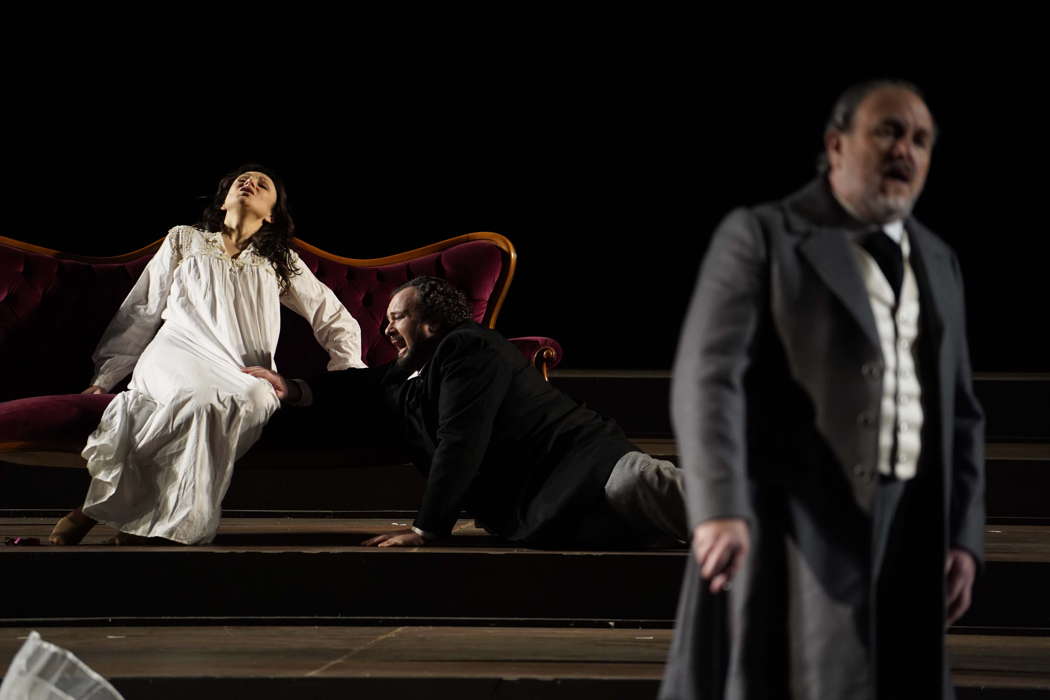
Irina Lungu as Violetta, Ştefan Pop as Alfredo Germont and Franco Vassallo as Giorgio Germont in Act III of La Traviata at Teatro Massimo Bellini. Photo © 2021 Giacomo Orlando
Some of the others may have needed additional direction and rehearsal. In the first act, the camera could have used less long shots and zooming. The staging gives a lot of emphasis to Giorgio Germont's hypocrisy.
Irina Lungu has sung La Traviata in all the major opera houses; she handles the role very well. She switches easily from coloratura soprano - the first act and most of the first scene of the second act - to dramatic soprano: from Amami, Alfredo to the end. Her emission is flawless. She deserves very high marks. Ştefan Pop is a generous tenor; I heard him as Alfredo at Teatro dell'Opera di Roma in 2009 in Zeffirelli's famous production. He knows the role inside out. I would prefer him slender and with a higher texture. Nonetheless, he is quite effective. Franco Vassallo is an old hand too. He knows all the tricks and makes Giorgio Germont really despicable in the first scene of the second act, and engrossing at the end of the third act. All the others are good.
Fabrizio Maria Carminati conducts the orchestra well and the chorus is flawless. The choreography is simple but good.

About a week later, RAI3 broadcast on 9 April 2021 in prime time, La Traviata produced especially for television by Teatro dell'Opera di Roma. The Roman production, much announced and much awaited, has had a huge success. 'The very high ratings demonstrate the great appreciation by the audience for our new production of La Traviata' - this is how the superintendent of Teatro dell'Opera, Carlo Fuortes, commented on the outcome. The film-opera directed by Mario Martone and conducted by Daniele Gatti, was seen by 967,000 viewers, with a share of 3.9%. The peak audience was recorded at 9.33pm, with 5.2% share and 1,424,000 viewers.
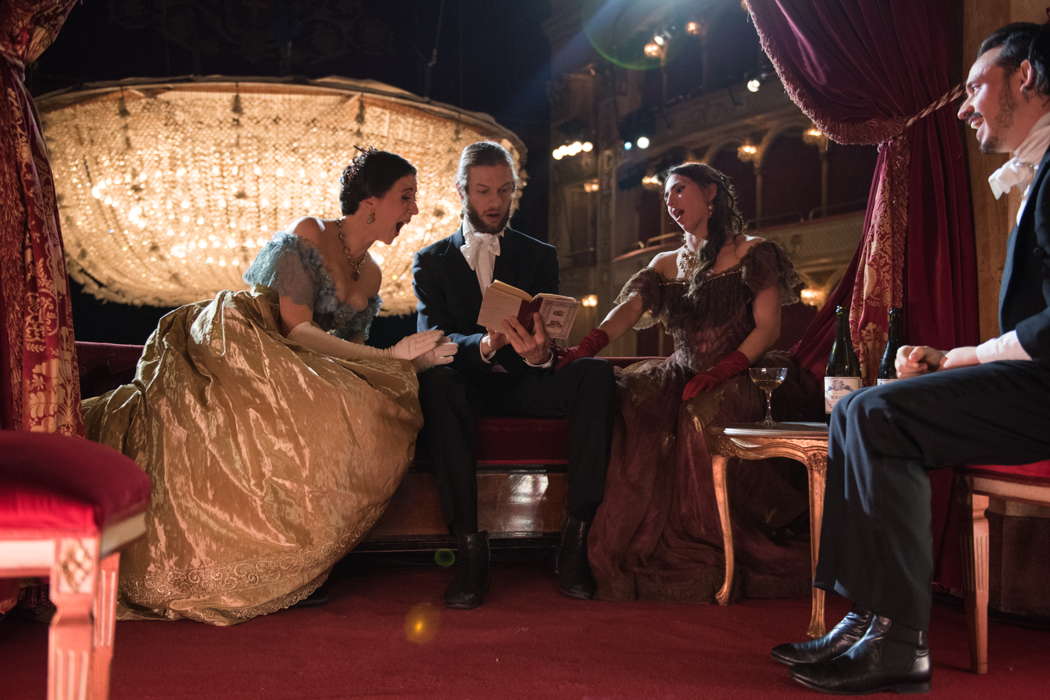
A scene from Act I of Opera di Roma's film-opera La Traviata. Photo © 2021 Fabrizio Sansoni
There is certainly no point in comparing the two television productions. The Catania production is meant for a subscription TV channel, the Roman staging for one of the major national networks. The former takes place in a jewel of art nouveau architecture of nine hundred seats; the latter in a theatre of about two thousand seats, drastically remodelled twice (in the nineteen thirties and nineteen fifties). The former was entrusted to three directors - two opera directors and one cinema director; the latter was staged by an award-winning director (Mario Martone) in both opera and cinema. There were two supposedly very different budgets.
The Roman Television Traviata was appreciated by the general audience but aroused perplexity in this elderly chronicler who has seen and known many stagings of La Traviata. I consider the best productions those by the Herrmann brothers - proposed a quarter of a century ago in London and imported to Italy by the Teatro Regio in Parma in 2007 - and above all that by Kasper Bech Holten, seen, also in 2007, at the Royal Theatre in Stockholm, where I believe it is still in repertory. They are, at the same time, the most modern and yet closest to Verdi's thoughts and music.
The Catania La Traviata perhaps lacked attention to the acting by minor roles – the three protagonists were very experienced of the relative parts – that of Rome suffered from an excess of dramatic direction.
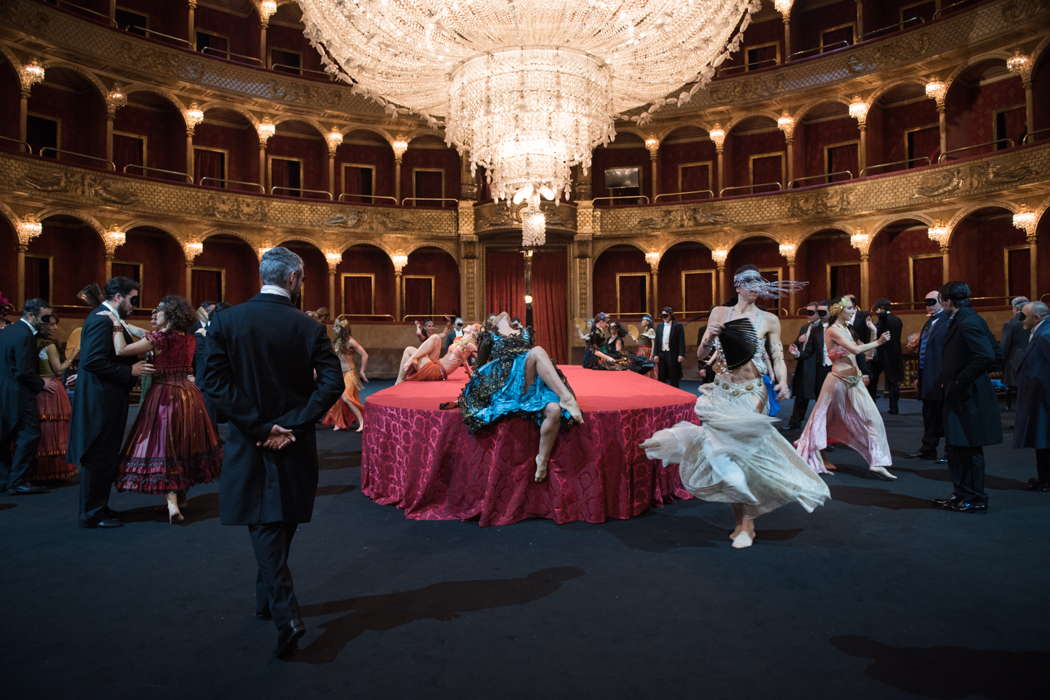
A scene from the second part of Act II of Opera di Roma's film-opera La Traviata. Photo © 2021 Fabrizio Sansoni
In the first act, it is normal to show Violetta's house as a luxury brothel, but what need is there to force Lisette Oropesa (Violetta) and Saimir Pirgu (Alfredo) to be lying on the stairs - an uncomfortable position to sing - during the duet, while the dances fervour in the foyer of the first order of boxes? Sempre Libera by Oropesa wriggling on stage was not good.
Worse still was the second act. The first scene takes place on the theatre stage with a large bed and a forest of trees, part of which collapses at the time of the rinunzia - Violetta's renouncing of her love affair with Alfredo. While Pirgu sings Or vanne, andrò a Parigi, you can see filmed images of Alfredo in a carriage on the Appia Antica way. Oropesa is in tight trousers, not suitable for emissions of Ah, dite alla giovine and even less to Amami, Alfredo, who should mark the watershed between a light coloratura soprano voice and a dramatic soprano style. Roberto Frontali is a wooden Giorgio Germont.
In the second scene of the second act, we return to the floor of the theatre, adapted to a brothel party: the chandelier of the theatre triumphs. Finally, Oropesa has a beautiful costume. The duet Invitato a qui seguirmi is sung in very uncomfortable positions, with the results that can be imagined. Above all, the great final concertato, one of Verdi's most beautiful pieces, is obscured by a film at the Baths of Caracalla of a duel between Alfredo and the Baron (Roberto Accurso), who seems to be killed, although the libretto says Il Barone fu ferito. Però migliora (the Baron was wounded but he is getting better). Alfredo writes this in the letter which Violetta reads in the third act.
In Act III, images of the parties of the first and second act are superimposed on Addio del passato and on Parigi, o cara. The carnival choir that should be off stage takes place in the corridors of the opera house. Violetta dies between an Alfredo who acts and sings with transport and a Giorgio as wooden as always.
It was difficult to make judgments about Lisette Oropesa in the difficult role, given the conditions in which she had to sing: the first lyrical part as a coloratura seemed better than the second as a dramatic soprano. Among the three protagonists, Pirgu excels: I have listened to him several times, also at the Tirana Opera House in a concert in 2011; great stage presence and acting as well as excellent emission, even in difficult conditions.
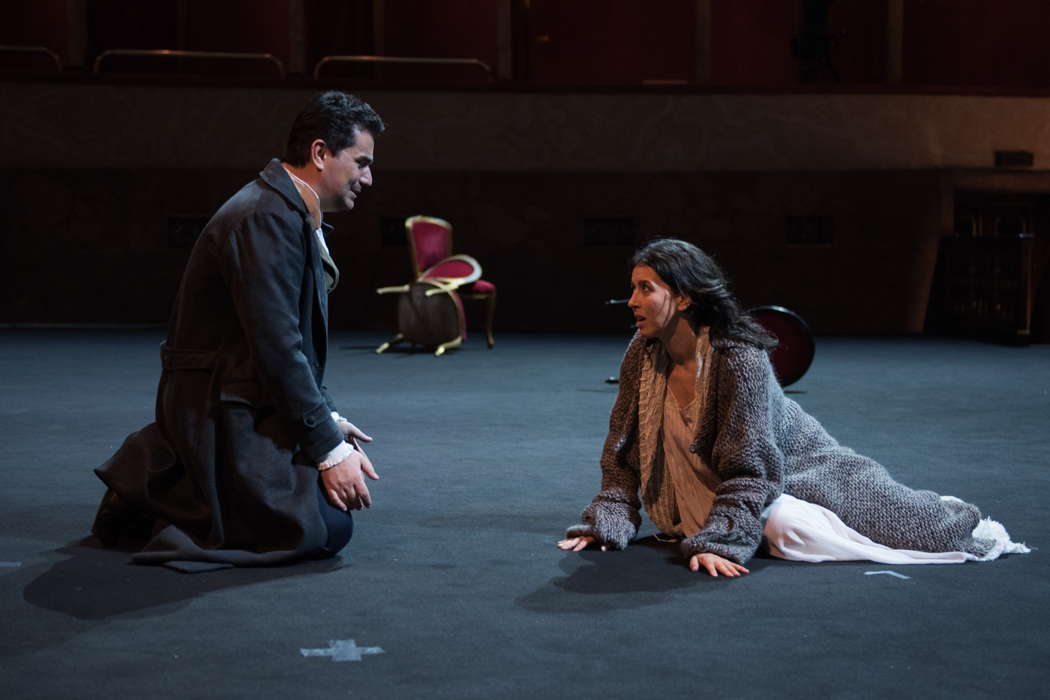
Saimir Pirgu as Alfredo and Lisette Oropesa as Violetta in Opera di Roma's film-opera La Traviata. Photo © 2021 Fabrizio Sansoni
Even Daniele Gatti no longer looked like himself: the passion undoubtedly was there, but the tempos were either too slow or too fast. To complete the information, Anastasia Boldy was Flora. Many artists of the 'Fabbrica' Young Artist Program of Teatro dell'Opera di Roma were involved in this production: Angela Schisano (Annina), Arturo Espinosa (Marquis D'Obigny) and Rodrigo Ortiz (Gastone), while Andrii Ganchuk was Dr Grenvil. The cast consisted also of Michael Alfonsi (Giuseppe), Leo Paul Chiarot (a servant) and Francesco Luccioni (a commissioner). The Rome Opera chorus was prepared by Roberto Gabbiani. The Ballet Corps was directed by Eleonora Abbagnato, interpreter of Michela Lucenti's choreography. Anna Biagiotti signed the costumes, while the lighting was by Pasquale Mari.
Copyright © 12 April 2021
Giuseppe Pennisi,
Rome, Italy



